Darkest Dungeon 2 charts a new path through terror in a roguelike road trip to save humanity
Just mind the 'Next Exit: Madness' signs.
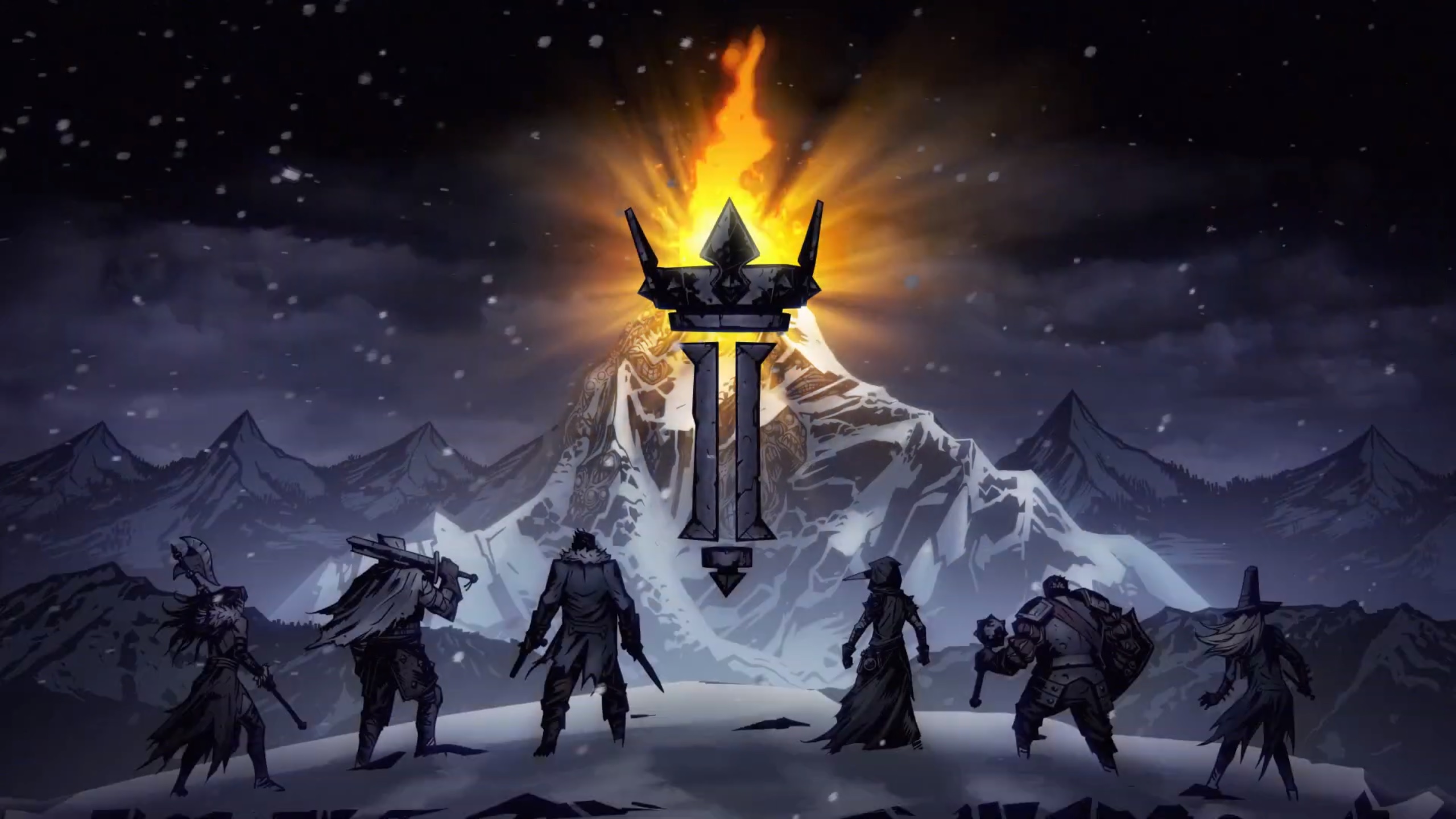
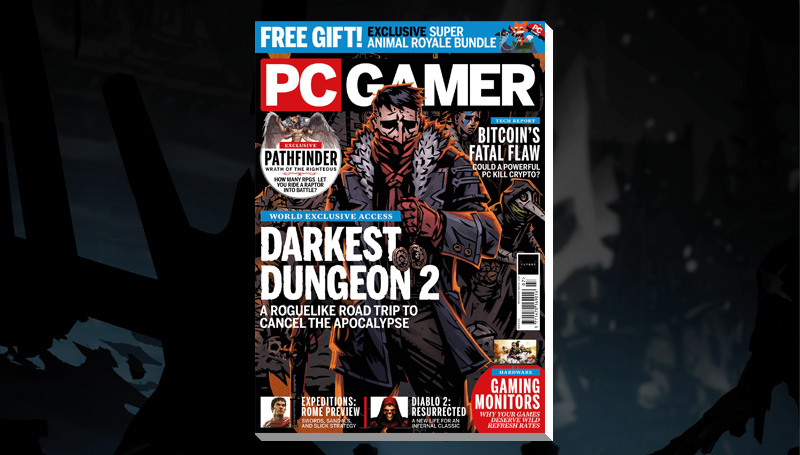
This article first appeared in PC Gamer magazine issue 358 in July 2021. Every month we run exclusive features exploring the world of PC gaming—from behind-the-scenes previews, to incredible community stories, to fascinating interviews, and more.
The world is dying. Tendrils of darkness crawl across the land, swallowing up everything but the battered road ahead and your flickering torch, the world's last hope for salvation. The apocalypse has arrived—but if that sounds bleak, you've probably never played Darkest Dungeon.
"The first Darkest Dungeon, the further you go down, the worse and worse and worse it gets," says Red Hook co-founder and creative director Chris Bourassa. Chris is about to convince me that this game about the end of the world, full of lost souls and horrifying monsters, is actually about hope. Darkest Dungeon 2 is a road trip, a roguelike mash-up of Darkest Dungeon and The Oregon Trail about clawing your way out of the darkness, rather than descending ever deeper into it.
Last wagon out of hell
"The more you learn about The Ancestor, the worse of a guy he is," Bourassa says, looking back on the story he and cofounder Tyler Sigman created for Darkest Dungeon starting in 2014. "This guy was the worst piece of shit in history. You get to the end of the game and you're like, not only is he the worst, but the whole world is the worst, everything's the worst… I feel like six years into Obama we were all ready to have some fun with nihilism, but it just didn't feel like we could go any further down. We went to the heart of the actual planet, revealed it's a monster, and then nothing matters."
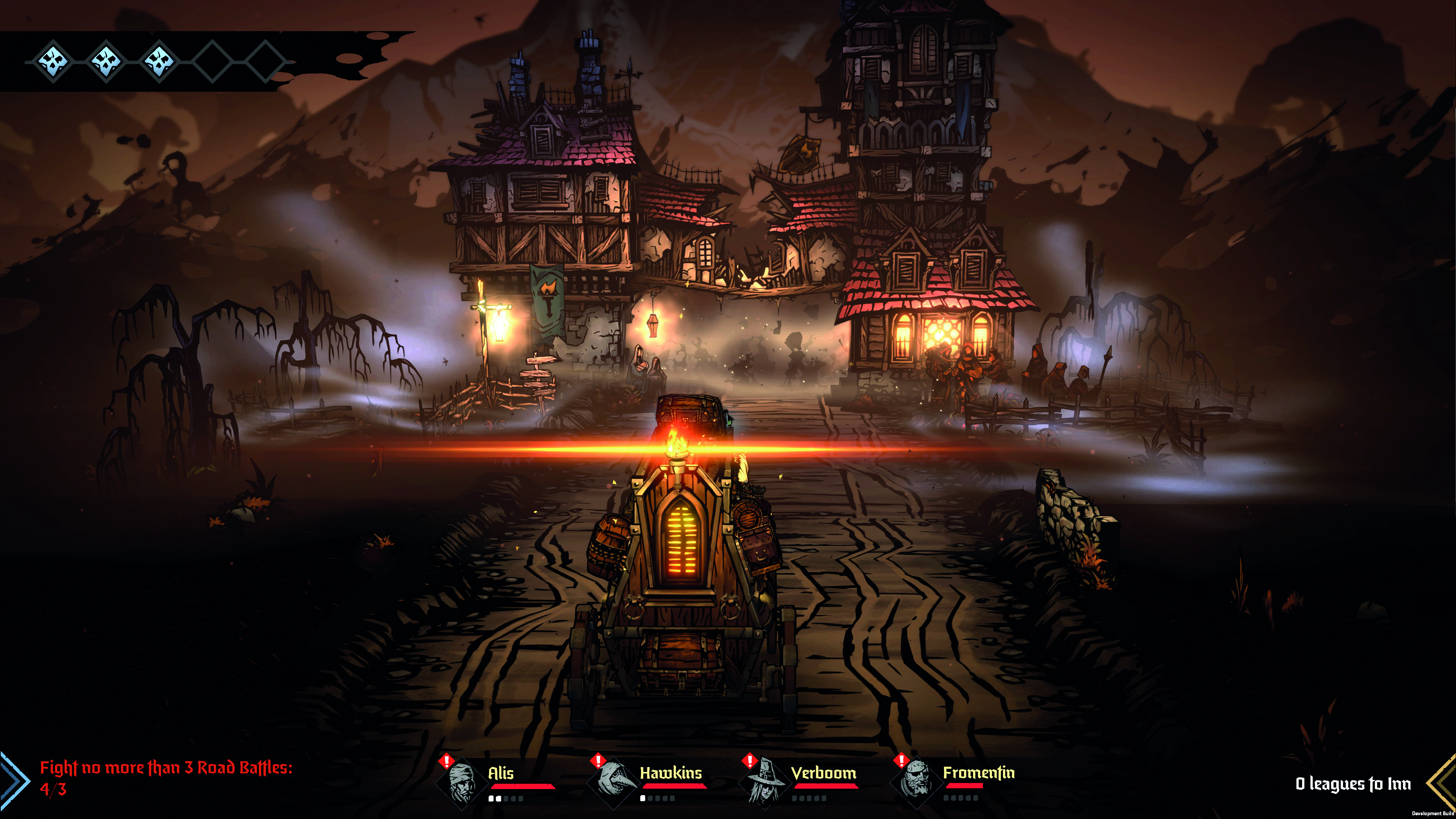
In Red Hook's first game, surviving a 40-plus-hour campaign meant putting dozens of heroes through the grinder and watching them go insane, then replacing them with fresh meat. Darkest Dungeon 2 wants you to care more about your flawed heroes. It's keeping the idea of quirks and stress creating unexpected, sometimes maddening surprises. But this time you'll be managing a party of only four heroes on a roguelike run to an ominous mountain, a brisk five hours if you survive the journey.
Shorter runs will hopefully be more inviting for players intimidated by the first game's enormous campaign. Like other modern roguelikes, there's meta progression between runs. And like Hades, DD2 will have a story that evolves over the course of development in Early Access. The idea is for the game to be easier to get into but just as deep once you're hooked. "We want more people to feel worse" jokes Bourassa.
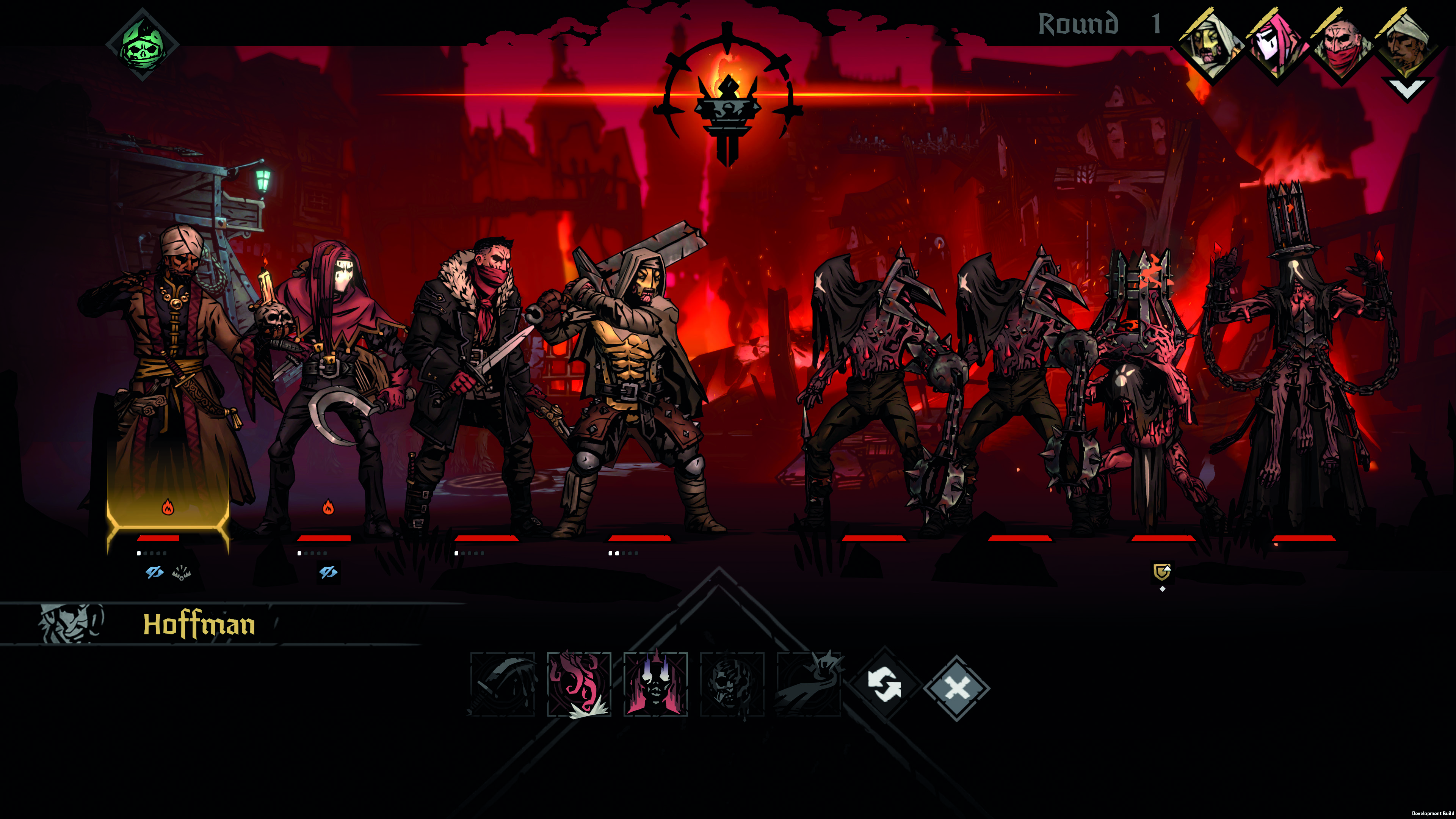
"There's some games where once you have the sequel there's no reason to go back and play the original. We wanted to do a different structure," says Tyler Sigman.
They settled on the idea of a road trip, which Sigman relates to the teensy-bit-brighter tone, likening it to Lord of the Ring's quest to Mordor. The trip may be brutally hard, but this time there's some nobility to it.
The biggest gaming news, reviews and hardware deals
Keep up to date with the most important stories and the best deals, as picked by the PC Gamer team.
💀Plague Doctor - A potion specialist who can heal allies and blight foes from the back row.
💀Occultist - A wielder of dark powers and strong crit chance who's especially strong against eldritch creatures.
💀Highwayman - With pistol in one hand and knife in the other, the highwayman is exactly who you hope not to run into on the road.
💀Man at Arms - A tanky defender who can buff other allies with block tokens, keeping them alive since healing is a rare treat.
💀Leper - A frontline bruiser who knocks back enemies and gets blind tokens after big swings. May need glasses.
"If you go back to this whole idea of settling West, it's people trying to achieve a better or freer life than their options where they are," he says (the Oregon Trail reference wasn't a joke). "I think those motifs, and dunking the ring in Mount Doom, are so powerful because the end goal is worth the trials of the journey. I think that is really important. The journey is terrible. You are leaving safety and going towards the worst possible thing you could, because somebody's got to do it."
A run in Darkest Dungeon 2 looks much like a journey up the tower in Slay the Spire or through the stars in FTL. Every region is divided into branching paths, each node a battle or ruin to investigate or an encounter with survivors who need your help.
Helping them is one way to keep your torch, the symbolic and literal light of hope, burning bright. Somewhere in each region is a proper dungeon, home to a tough boss fight and better loot. A powerful trinket could transform a run, but tackling it is risky: any hero you lose is dead for good.
"I don't think we could respect ourselves or look at ourselves in the mirror if we didn't kill your characters," says Bourassa. "They can die, and you can be on a run with two characters left. But we reward your progress at the end."
Are we there yet?
💀Jester - The sickle and lute aren't a likely pair, but the Jester pulls it off by buffing friends and bleeding enemies.
💀Grave Robber - Armed with darts and throwing daggers, the grave robber is a speedy killer with an excellent hat.
💀Hellion - The Hellion, who after DD1 had a starring role in Horizon Zero Dawn, uses a giant glaive to slice up enemy back rows.
💀??? - What role will this mysterious newcomer fill? My guess is another heavy frontliner or a member of some new faction being introduced in DD2.
Like in a real-life road trip, Darkest Dungeon 2 is all about the personalities in the car. "I've done a few of them in my time, and you end up best friends with somebody and never talk to the other guy again, ever," says Bourassa. They've recreated that dynamic by tossing out the old afflictions caused by stress and creating an affinity system, where characters gain and lose favour with each other. Relationships have tendrils into every corner of the game. When you come to a crossroads, all four will have an opinion about which way to go.
When you encounter strangers, your highwayman might want to rob them, while your man at arms wants to give them food. Whichever option you pick, somebody's likely going to end up angry and stressed. In combat, if your grave robber is near death and you have your plague doctor toss a healing potion to your highwayman instead, how do you think the grave robber's going to react?
Rack up enough positive or negative reactions and characters will form relationships. Good ones will pay dividends: friendly heroes might "pull a Kevin Costner bodyguard" or "double-up Capcom style on the enemy", Bourassa says. But this being Darkest Dungeon, there are a few million ways for relationships to go terribly, terribly wrong.
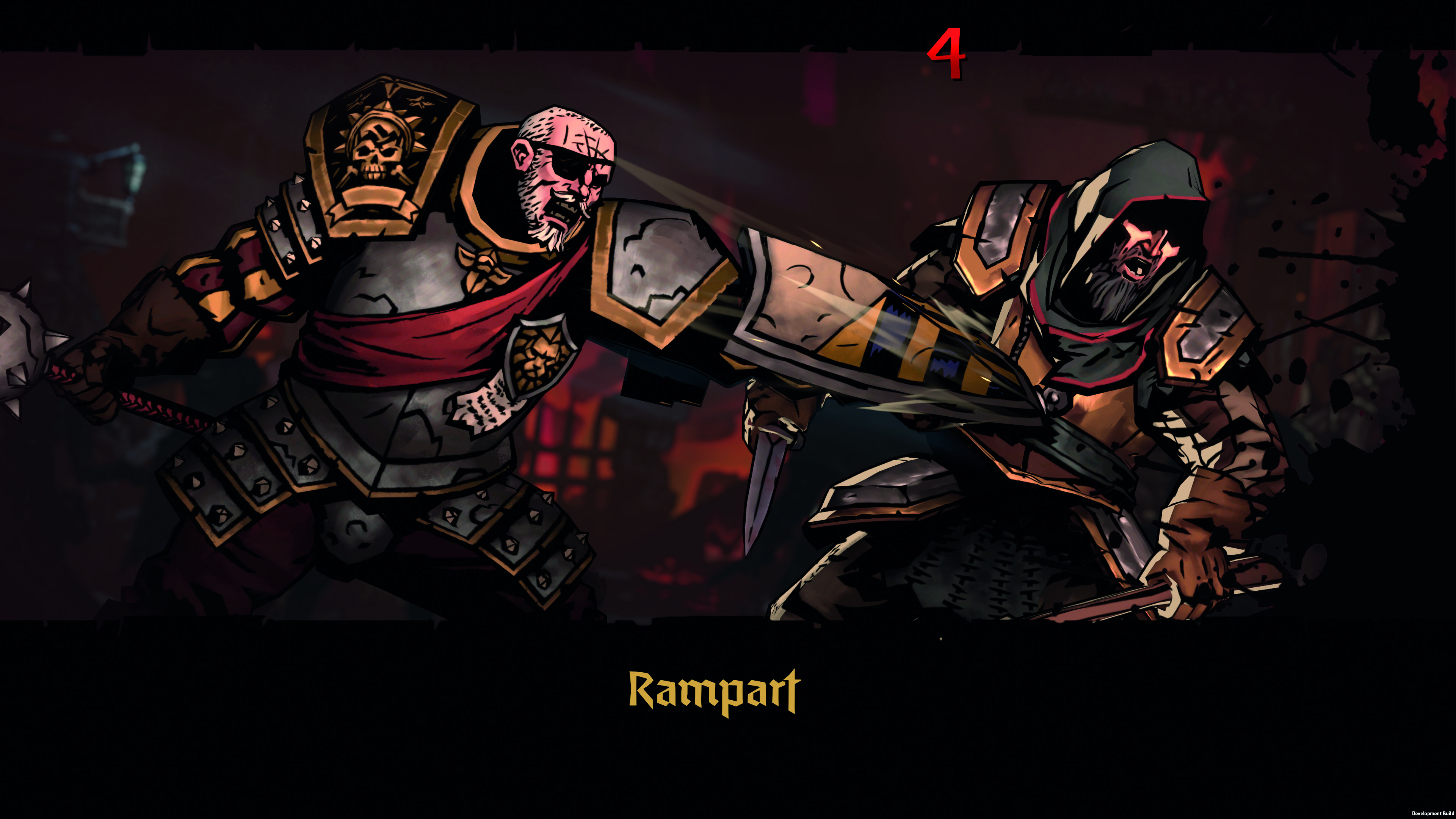
"We like that every run can have a story. You can have a grave robber who gets hit with too much stress early on, then just gets real crummy to everybody. Hateful with the man at arms, jealous of the highwayman, just a toxic person. But she's probably better off alive than dead for the health of you run. That becomes the story of that time you had that awful lady in the back of the car and she was really mean to everyone."
Character quirks like 'clumsy' or 'kleptomaniac' will affect how members of your party play off each other, and stress piled on by being dragged to the dungeon or watching a friend die in battle can make them spiral out of control
Character quirks like 'clumsy' or 'kleptomaniac' will affect how members of your party play off each other, and stress piled on by being dragged to the dungeon or watching a friend die in battle can make them spiral out of control. Unlike in the first game, a full stress meter won't trigger a heart attack – it'll trigger a meltdown, where their health drops to death's door and all their relationships are reset. Their ensuing tantrum will stress everyone else out too, of course.
There may be runs where you intentionally trigger a meltdown to reset nasty relationships. You can also try to build positive bonds at the inn where your weary band will rest at the end of every region (it replaces camping from the first Darkest Dungeon). You can have your characters share a game of cards or a bottle of booze and hope they hit it off, but a negative quirk like egomania could make your good intentions backfire. "We always want to put you in a place where you're trying to make the most of a sub-optimal situation," says Sigman.
Battle lines
If you haven't played much Darkest Dungeon, combat in the sequel will look much the same to you. Your party still stands in a line, a selection of skills below. Each character's position is key, since skills can only hit certain distances. With each attack you get a cutaway animation as blade or bullet hits flesh.
If you have played a great deal of Darkest Dungeon, combat will look strikingly different. It's in 3D now, for one thing, as is the whole rest of the game. Characters have bigger bodies and smaller heads, no longer cartoonishly proportioned.
"There's really amazing preparatory animations in combat," Bourassa says. "If you click 'wicked slice' on your highwayman he whips his knife out and gets ready, and when you click a target he follows through. The result is combat feels way more alive. People are getting potions out and then launching them on your mouse clicks. Once you get into a flow, if you watch someone who knows how to play, even though it's turn-based it feels very fluid."
There are even more dramatic mechanical changes. Characters no longer have upgradeable armour or weapons, or stats like dodge and accuracy. These sweeping changes make combat 'chunkier' – designer speak for 'easier to understand.' Clearer information makes each turn more of a puzzle to solve than a slugfest to endure.
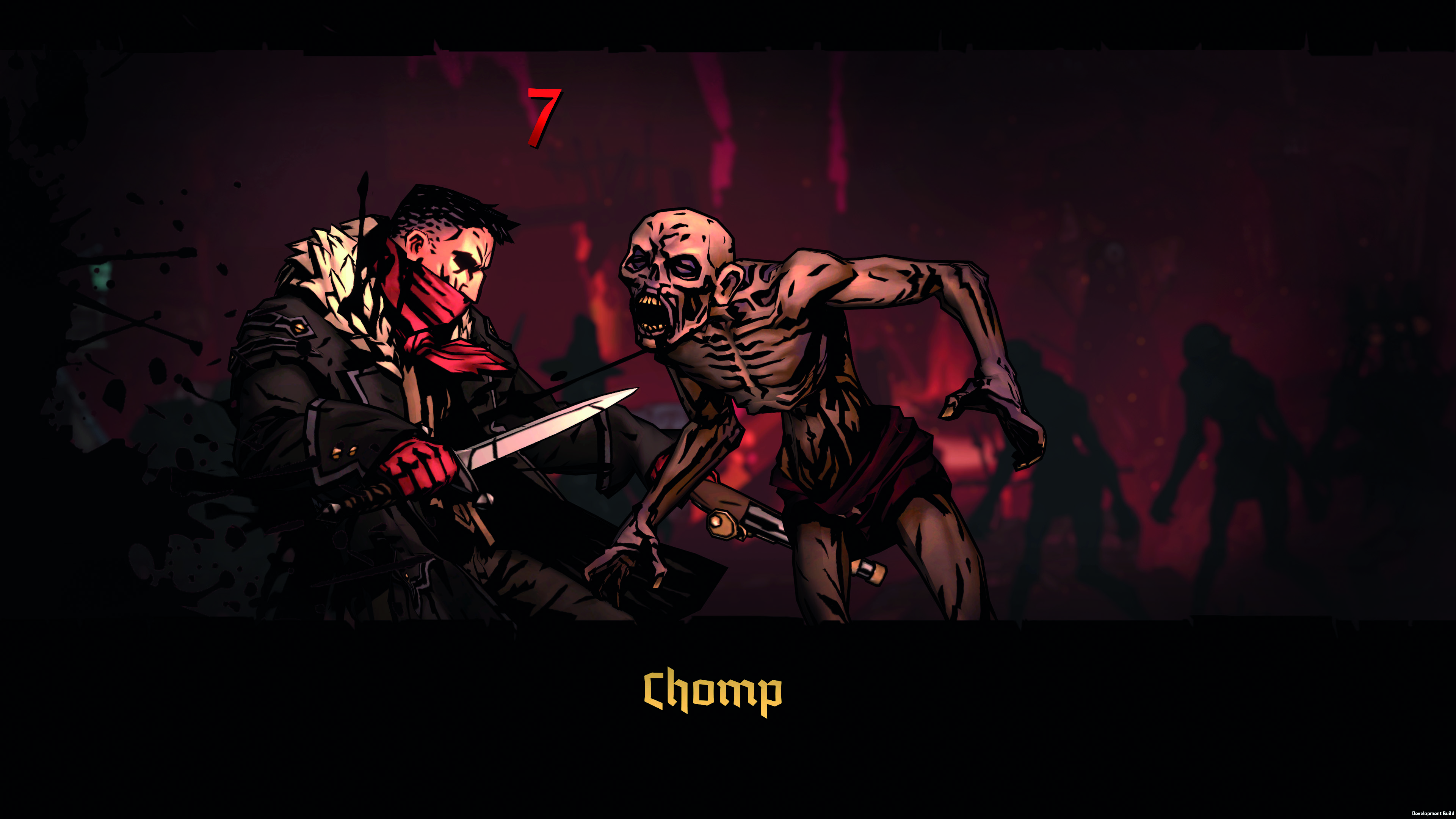
Darkest Dungeon 2's battle makeover started with a radical move: ditching accuracy altogether. "We found over time that people just dislike missing so much that we ended up tuning up accuracy quite a lot over the lifetime of the [first] game," Sigman says. "So what if we just got rid of accuracy as a stat? You hit. You know you're going to hit – unless the opponent is dodgy, unless they have a block." To convey a dodge or a block, they condensed percent chances into tokens that represent concrete effects. If your character or an enemy has a block token, they're guaranteed to absorb 50% of their next hit.
"We started doing that with all the mechanics and it was kind of an experiment at first. The concern was what if we make it too simple, but it ended up working." Sigman compares the token system to a card game like Hearthstone, where if an enemy has a creature with taunt on the board, that's an obstacle to work around. Almost all the effects from the first game have been converted to tokens – immobilise, stun, bleed, blind, even team-up combo attacks.
"It gets people thinking a little bit more," Bourassa adds. "I found that it erodes the natural inclination we saw in the first game for people to just use damaging attacks all day long." And so you now get to see the next few turns in the turn order, letting you plan out multiple moves in advance.
Trinket for your thoughts
Characters do still have some stats: hit points, speed and resistances to status ailments like blight. But the simpler pool helped Sigman go wild designing trinkets, the only gear you'll be equipping. Once you found a trinket in the first game you could keep it forever, so popular strategies revolved around the most powerful ones. Trinkets usually had a negative stat trade-off, but only a few stats really mattered, so the design options were limited.
That's the fun of a true roguelike. Sometimes you have a run and you get a crazy item and you're like 'I'm unstoppable'
Tyler Sigman
In DD2 you may get lucky and find an awesome trinket in one run, but it'll be gone the next. "So basically we can get crazy," Sigman says. Instead of percent tweaks to stats, trinkets can now grant effects like starting every round with a pair of block tokens, or getting a crit token every time you miss an attack (which could stack well on the leper, who blinds himself after landing big hits). "That's the fun of a true roguelike. Sometimes you have a run and you get a crazy item and you're like 'I'm unstoppable'. That's a really fun place to be as a player." Trinkets will be divided into some standard loot tiers: commons, rares, epics. But there will also be trinkets unique to certain bosses and certain factions of enemies. Those will dangle an incentive to chance taking on a dungeon or fighting a tough battle against cultists to luck into a particular drop.
"There are a lot of trinket-based interactions and class skill interactions you can try to maximise," says Bourassa. "There's a lot of ways you can mitigate a class's downsides with trinkets and some help from his friends. That's awesome, but where we're hoping our game really comes into its own is 'what if they hate each other?' They won't do [what you say], so you're sort of stymied even though you do have the optimal strategy in mind. I think that's quintessentially what we've tried to explore."
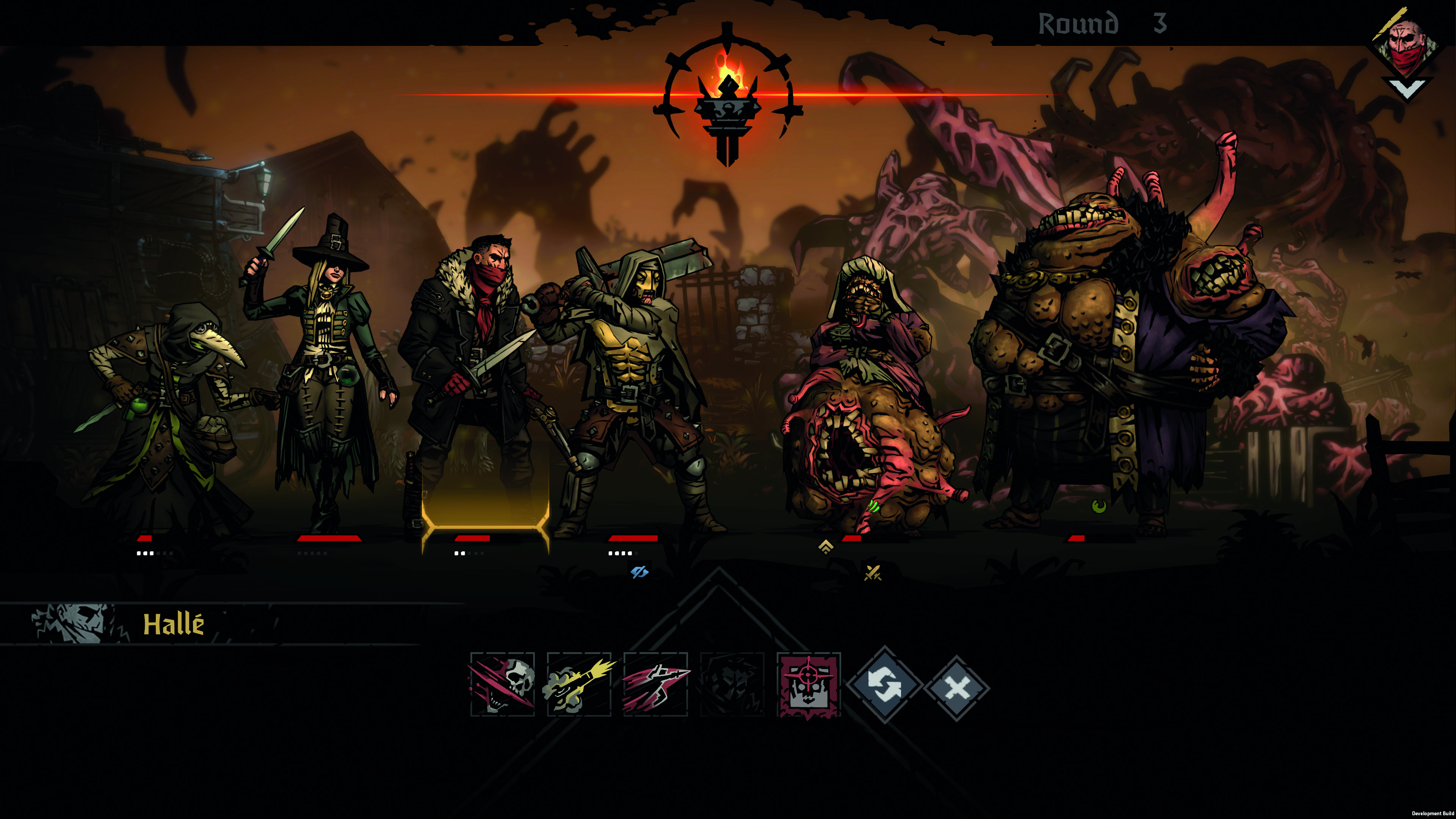
Skills for kills
Darkest Dungeon 2 is launching with nine heroes: eight familiar haggard faces and one new one still under wraps. Each returning class is now significantly expanded, from a pool of seven skills to eleven. You unlock more advanced skills by completing special encounters for each hero on multiple runs. "We want you to feel rewarded that you put some time in the game. It directly translates into more flexibility in the run, more team comps you can put together, and a greater chance of success," says Sigman. "It's not that we give you crappy skills to start, but the more skills you have the more you can adjust to the changing conditions on the road."
Those unlocks will go hand-in-hand with learning Darkest Dungeon 2's regions, so you'll know when you head into a region where enemies have high blight resistance, it's time to adjust your plague doctor's loadout. You can swap out skills on the road between encounters.
But Red Hook never giveth without takething away. You can no longer have multiple copies of the same hero in your party, and each run you have to choose from a bunch of heroes pre-rolled with a good and bad quirk. "It's not like Wizardry from the 1980s where you keep rolling till you get 18s across the board," says Sigman. "If you really wanted a leper this run but he's a pacifist or whatever, that makes you really choose."
Restricting you to a just single hero type per-party made the game easier to design – Sigman no longer has to think about what a party of four lepers plays like. But that decision was ultimately more about the characters themselves, "It keeps that experience of each hero being super unique and vital as a key part to that SWAT team."
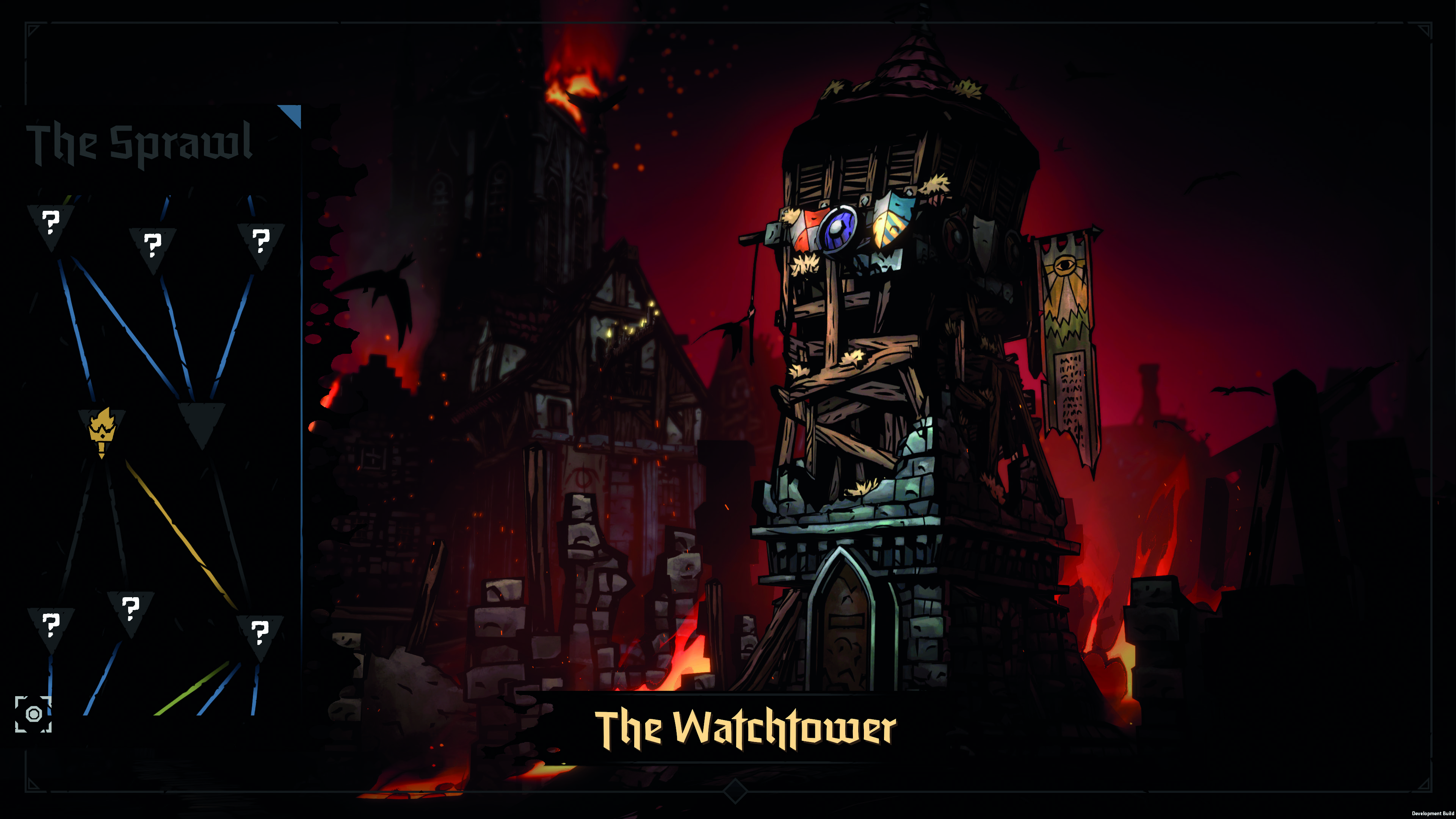
Forward unto dawn
Darkest Dungeon ended up with 18 classes after years of expansions. Darkest Dungeon 2 will grow, too. It's coming to Early Access in Q3 2021, and you'll be able to complete a run from the get-go: if you survive long enough to haul your flickering torch to the mountain's peak, ready to stop the world from crumbling, you won't be greeted by an 'under construction' sign. Bourassa says to expect a five-act story, with each act bringing a new boss to fight when you reach the mountain. It'll launch with act one.
You can have your characters share a game of cards or a bottle of booze
There will be four regions to struggle through at first, but the roguelike structure makes it easy to add more—likely in themed releases similar to the first game's. I imagine Darkest Dungeon 2 in its final form like a version of Mad Max Fury Road, where you find an epic trinket in the Bullet Farm on one run and die of blight in Gas Town on the next one.
It's hard to believe that the first game was built by a core team of just five people. Thanks to its success more than 20 are now working on the sequel. The bigger team means there are designers focused solely on creating monsters or heroes or skills, tasks Sigman once juggled while also managing payroll. Artists and animators are doing things with the new 3D models that would require more illustrations than Bourassa could've ever created by hand. But they're both still in the trenches.
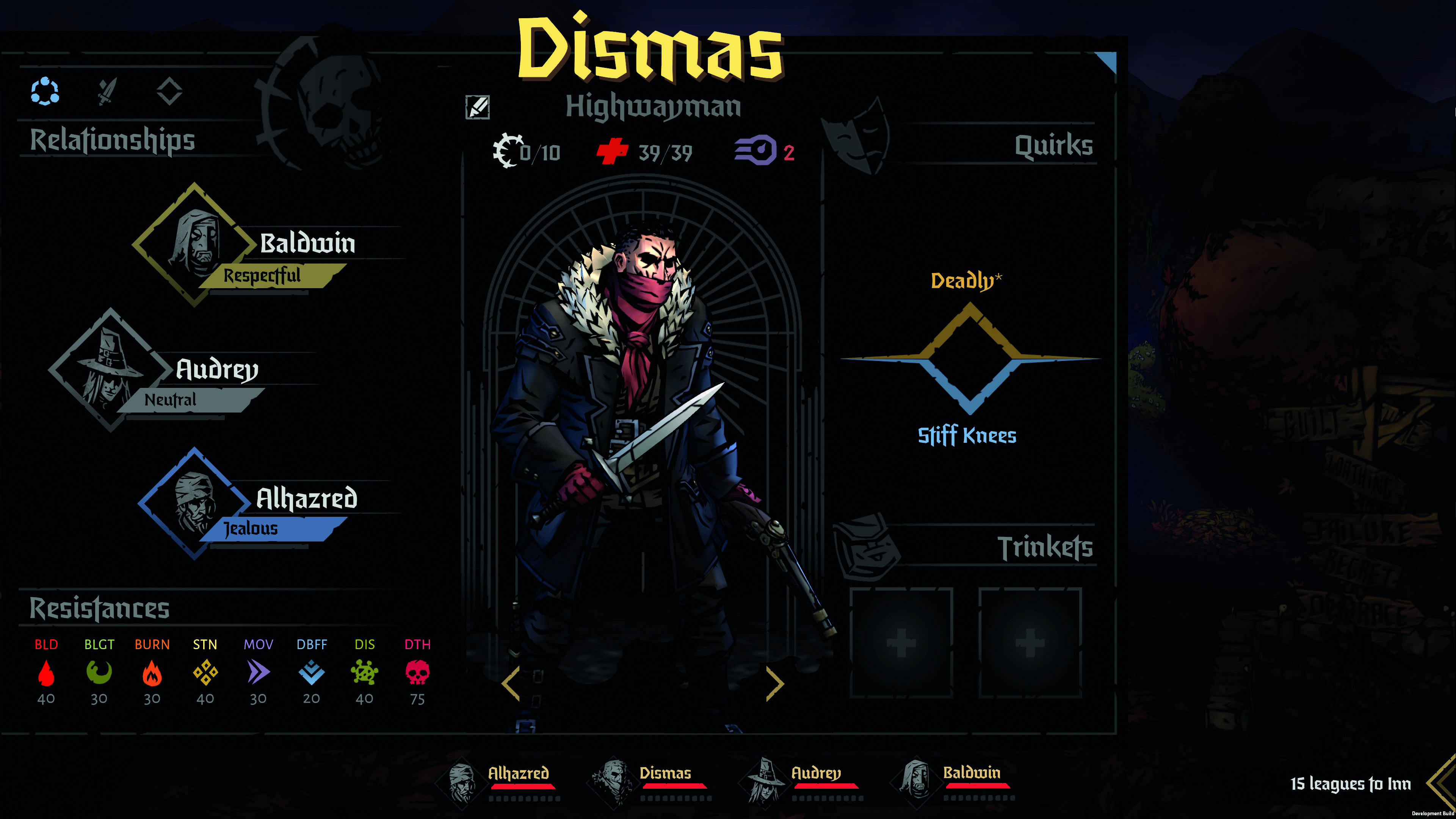
"It was important we own it and have our hands right in it," says Bourassa. "All we know how to do is what we did the last time. If we throw all that out and hire a bigshot producer from EA to just run the whole thing, we don't know where that leads, right? All we really know is the experience we had together. So we tried to preserve as much of that as possible and still create inroads and ownership for the team along the way. It really stems from, we don't want to fuck it up, quite frankly."
In our hours of talking about Darkest Dungeon 2, neither of them belaboured the connection between its more hopeful metaphor and their own intense creative process – that they both feel the need to take risks to make a videogame that satisfies them. But when my first run inevitably goes to hell and I contemplate leaving my petty egomaniac plague doctor by the side of the road, I know I'll think back to how Chris Bourassa describes the feeling he hopes this sequel can evoke after Darkest Dungeon's bottomless nihilism.
"This game is more about trying to swim up, hoping you have enough air to break the surface, and the fear that you experience when you realise that it's just a little further out of reach each time," he says. "It's about trying to surface and trying to come to grips with your failures. But if you can manage to do it, there is a path to a better future." Or, at least, a path to a better trinket.

Wes has been covering games and hardware for more than 10 years, first at tech sites like The Wirecutter and Tested before joining the PC Gamer team in 2014. Wes plays a little bit of everything, but he'll always jump at the chance to cover emulation and Japanese games.
When he's not obsessively optimizing and re-optimizing a tangle of conveyor belts in Satisfactory (it's really becoming a problem), he's probably playing a 20-year-old Final Fantasy or some opaque ASCII roguelike. With a focus on writing and editing features, he seeks out personal stories and in-depth histories from the corners of PC gaming and its niche communities. 50% pizza by volume (deep dish, to be specific).

